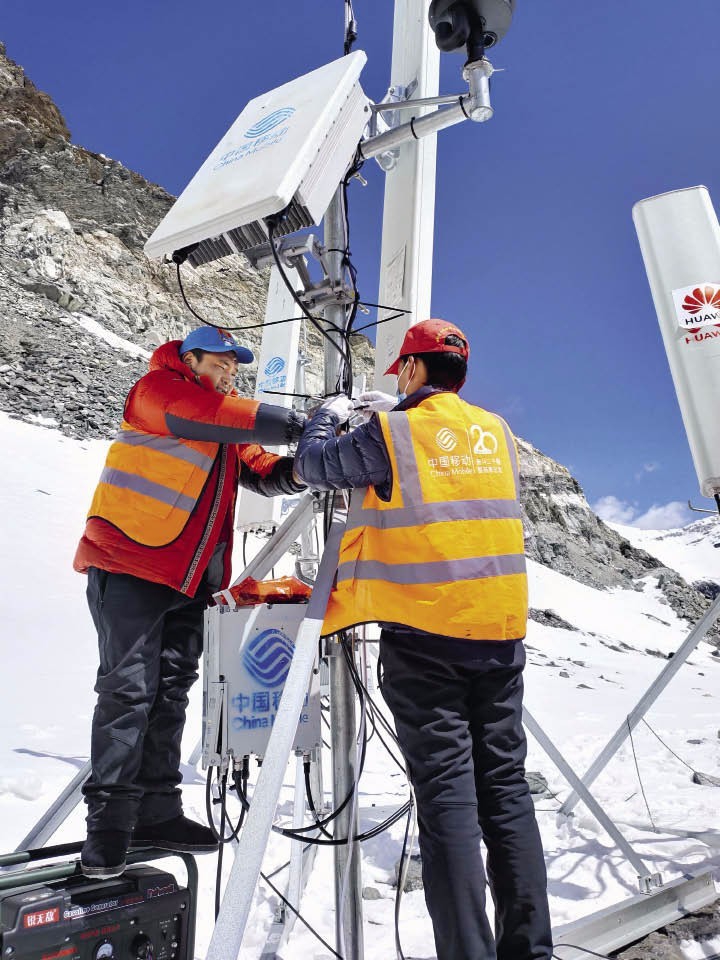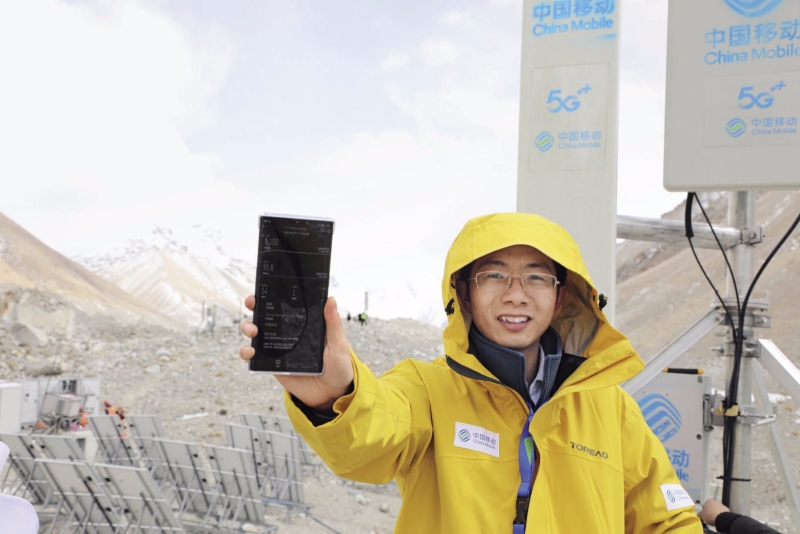“China Mobile and Huawei built a 5G base station on Mt. Qomolangma at an altitude of 6,500 meters within a short period of time and under extremely harsh circumstances. This accomplishment testifies to the maturity of China’s 5G industrial chain,” said Wang Bo, a manager of Huawei’s Lhasa branch.
On the same day, Chinese surveyors held a press conference at the 5,200-meter-high base camp of Mt. Qomolangma and launched China’s mission to remeasure the height of the world’s highest peak. Coinciding with the 60th anniversary of the first successful human ascent of Mt. Qomolangma from its north slope and the 45th anniversary of China’s first accurate measurement of its height, this mission has special significance for both China and the world.

A 5G base station jointly built by China Mobile and Huawei at the 6,500-meter-high advanced camp of Mt. Qomolangma.
“With stations at the base camp and transition camp that were built earlier, 5G signals are now, in theory, covering the north slope route and the summit of Mt. Qomolangma,” said Wang. The 5G network of China Mobile provides vital telecom services for surveyors of the 2020 measurement mission and their supporting team.
Heading into the Forbidden Zone
The first group of engineers and workers of China Mobile and Huawei arrived in the Mt. Qomolangma base camp on April 10, after which they immediately started to work. Within just eight days, a 5G base station 5,300 meters above sea level was completed. And the Internet speed in this area exceeded engineers’ expectations: above 1.66 Gbps for downloading and as high as 215 Mbps for uploading.
Being well aware of the harsh conditions and low temperatures at the high altitude of the region, China Mobile chose Huawei as the solution and equipment provider for this monumental project, and Wang Bo was appointed to be the technical supervisor for it. “We were excited about accepting the mission, because we would witness and make history for telecommunication at high altitudes. But after the work started, especially in the later stage where there were higher demands for the construction speed and Internet transmission quality, pressure began to mount up. A heavy sense of responsibility weighed on our minds like a ton of bricks,” Wang recalled. In addition to the usual stress that is associated with the work, he also had to cope with altitude sickness. “Due to a lack of oxygen, I may wake up at any moment in the night, feeling like I was suffocating,” Wang said.
As it is not allowed for people without special training to work in areas at 5,800 meters above sea level or higher, Wang did not go any higher after the 5,300-meter-high base station was completed. In his place, his colleague Li Kui led the team to the next camp further up the mountain.
Before the mission, Li and other members of the team had undergone training on topics of self-care in extreme natural conditions and environmental protection. But despite the preparations, it was still not easy for them to adapt to the environment once on the ground. During their first excursion of transporting power generators to the transition camp, a yak died of exhaustion and a generator was severely damaged after it fell to the ground. The environment is a grim challenge even for high-altitude animals, and more so for people who come from a lower altitude.
At the transition camp Li and his team built a 5G base station in four days. He then moved on to the advanced camp at an altitude of 6,500 meters, accompanied by only three engineers and two guides.
Later, after trekking through an icy storm and braving strong winds, the team finally reached the advanced camp that was shrouded in mist. Despite its ethereal scenery, the region sustains little life due to its thin air. Li soon began to show strong symptoms of altitude sickness, including splitting headaches during the first day, diarrhea the second day, and incessant nausea and vomiting the third. “It felt like all organs were churning inside my body and would explode at any moment,” recalled Li. But as a result of his determination to finish his assigned task, he stayed and worked on despite his physical discomfort. “Not everyone has the opportunity as we do to participate in such a mission,” said Li.

A 5G base station 5,300 meters above sea level starts operation at 12:30 p.m. on April 15.
Prioritizing Environment-Friendliness
Extending 5G signals to the summit of the world’s highest mountain is no doubt a breakthrough in the application of 5G technology in China and provides strong support for its 2020 surveying project. It is the first time Mt. Qomolangma was covered by the terrestrial communication system.
To ensure a consistent signal covering the 28 kilometers from the base camp to the top of the mountain, China Mobile designed a scaled network bolstered by base stations in the base camp, transition camp, and advanced camp, choosing the 6,500-meter-high advanced camp as the site for the highest base station. To reach the advanced camp, the engineering team had to walk for at least seven hours from the transition camp. The two localities are only 700 meters apart vertically, but the climbing route is 10 kilometers long, and in an environment of thin air, every step is a great exertion, even more so since they were carrying equipment with them. It took more than 10 minutes for them to cover a few dozen meters.
Environmental protection was a top priority during the construction in a region that has such a fragile eco-system. Normally poles at telecom base stations are secured into the ground with cement, but cement is banned in the Mt. Qomolangma region. As a result, the engineers replaced it with rocks sourced from the mountain.
To minimize the impact on the natural environment, engineers chose to use an armored optic cable and laid it without digging or altering in any other way the environment in the core zone of Mt. Qomolangma. They also meticulously collected and properly disposed of the waste produced during their stay in the mountain area.
Due to bad weather, the two 5G base stations at the advanced camp began operating on April 30, five days behind schedule. Today, all five 5G base stations at Mt. Qomolangma are already in use. To meet the needs of daily life and work of its staff stationed at the mountain, China Mobile adopted Huawei’s SingleFAN Pro solution to build a F5G (Fifth Generation Fixed Network) network covering all the camps on Mt. Qomolangma.
Shidar Puncog, a project manager of China Mobile, told China Today, “Facing the extreme conditions at the world’s highest peak, the SPN-based solutions jointly developed by China Mobile and Huawei stood the test of a demanding natural environment, and our mission was completed successfully. The 5G coverage on the mountain is not only a challenge to human limitations, but also lays a solid foundation for the development of various activities in the region including tourism, scientific exploration, and rescue climbing.”